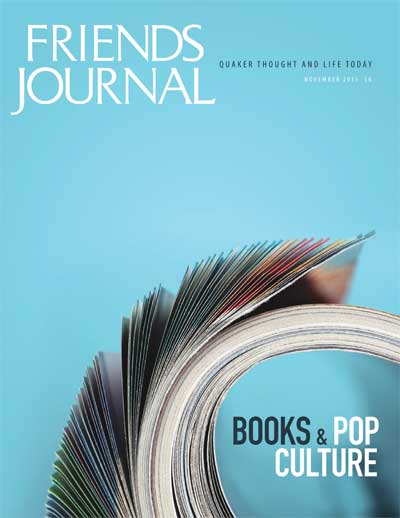As the cool nights of November creep in, we here at Friends Journal like to curl up with great books and present our annual Books issue. A baker’s dozen of new reviews in these pages should keep you warm with a winter’s list of great must-reads. Our reviews are one of the most consistent and ambitious features of the magazine: over the course of any given year, dozens of volunteers write over 100 reviews.
In this issue we’ve turned the tables. We interview Journal poetry editor Rosemary Zimmermann and ask the perennial question, “Is there such a thing as Quaker poetry?” We also survey almost 40 of our regular book reviewers. My favorite question for them is “If you could get every Quaker to read one book, what would it be and why?” We’d love to hear your picks, too, dear reader.
This year we also wondered how Friends interact with mass media and pop culture. We found some surprising crossovers. For instance, I’ve long assumed our influence is minimal in the new epicenter of media: the tech outposts of Silicon Valley. While most of us have joined the brave world of over-sharing and interconnection, I guessed we were passive consumers of the new technologies.
But it turns out there’s a fascinating connection with one of the most remarkable of the new media resources. At the time that a publicly editable online encyclopedia launched in 2001, I laughed at its prospects. I was sure that this strangely named “Wikipedia” could never be as accurate as the beloved Funk & Wagnalls of my childhood. How could a group of volunteers with limited hierarchy and few rules possibly organize themselves in a mission so ambitious? As a Friend, an answer should have been obvious: consensus! We interview Wikipedia’s Sue Gardner about how the culture of the organization grew to embrace a consciously Quaker-influenced model of decision making.
Our fingerprints are elsewhere in the pop culture landscape. Justin Leverett looks at the mass media’s attempts to navigate the very Quakerly concerns of integrity and nonjudgmental coalition building and shares stories of Friends who have braved the lion’s den of pugilistic cable shows to share informed pacifist alternatives.
The online connection also pops up in our Quaker outreach. This month’s Let’s Grow Together interview features a new Friend from Maryland who learned of Quakers via an online quiz. These viral questionnaires from PlayBuzz and Beliefnet can be laughably inaccurate, but they’ve brought hundreds of seekers to the front steps of our meetinghouses. How do we invite the curious masses to brave that first visit and come back enough times to become part of our spiritual community? (Hint: perhaps a Friends Journal gift subscription?)
The popularity of these online quizzes suggests that we might be close to one of the pop culture alignments that we Friends seem to line up with every few decades. Keith Helmuth pulls together six Quaker “memes”—ideas that underpin modern Quakerism but also have a strong resonance in the wider culture. It’s a convincing list. Are we ready to share these insights and the wider Quaker experience in our online and real world interactions?





Comments on Friendsjournal.org may be used in the Forum of the print magazine and may be edited for length and clarity.